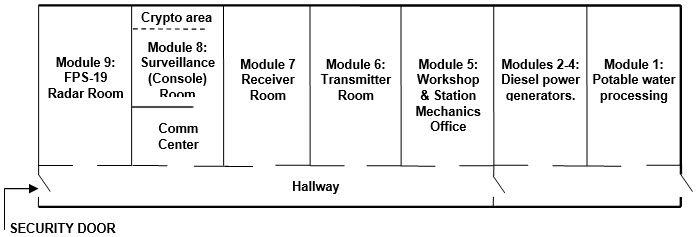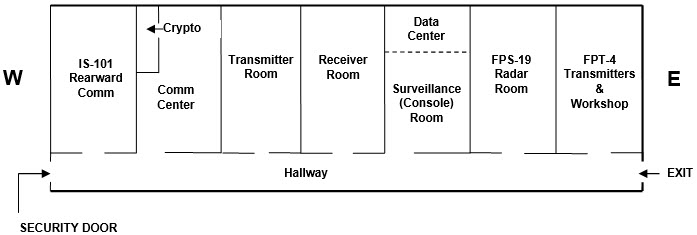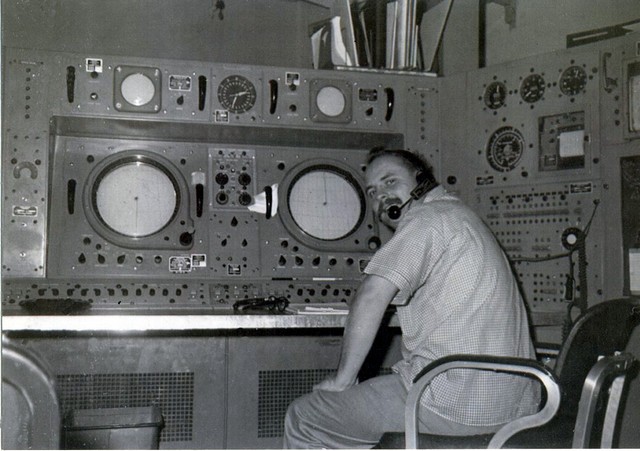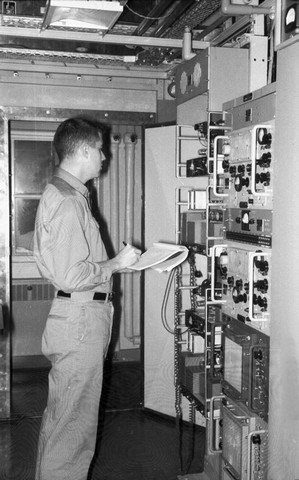The Life of a DEWLine Radician
By Radicians Brian (Simon) Jeffrey & Paul Kelley
What is a Radician?
The term Radician is a contraction of the words RADar technICIAN and was the job title given to the electronic technicians who maintained the radar and other electronic systems on the Distant Early Warning Radar Line (DEWLine).
The Radician’s Job
It was intended that Radicians would be available to provide both preventative and corrective maintenance on a 24/7 basis on each station. To accomplish that, there would need to be 3-4 Radician per station allowing for 3, 8-hour shifts per day plus a day off. It didn’t work out that way as you will see below.
Here is an extract from the Lincoln Laboratory Journal dated Nov 2, 2000.
“The conventional manning of standard radar stations of the period was impractical for the extreme operational environment of the DEW Line sites. At the time, a line comprising standard air-defense radar stations required several hundred personnel per station, an unsatisfactory approach because of the need for an extensive and expensive logistics supply system. Each standard radar station had ten to fifteen operators who viewed the radar output on plan position indicator (PPI) displays. One set of operators detected and tracked incoming aircraft, another set tried to identify the aircraft, and a third set guided fighter aircraft to intercept the unidentified aircraft.
With the DEW Line, only the first two functions, detection and verification of attack were necessary. A total manning of only ten personnel per station was the objective, which put special emphasis in the DEW Line project on improvements in operator functions and the use of more automated processes.”
The report went on to point out:
“The DEW Line was based on the premise that small groups of people could be deployed to remote radar sites in the far north and could work at other tasks while listening for radar targets. The use of automated detection, including the generation of audible alert signals, accomplished two goals for the project developers. First, it reduced the number of personnel required for each site. Second, it compensated for the recognized unreliable detection capabilities of humans in situations of low-probability targets.”
The problem was that the automated alarm system, the Radalarm X-1, proved difficult to adjust and prone to false alarms. It was quickly abandoned and turned off by the operating crews. This meant that humans (the Radicians) would have to monitor the radar consoles (PPI displays) 24/7. This, in turn, necessitated doubling the number of Radicians on a site. A typical site would now have a complement of 7 Radicians instead of the originally planned 3-4.
The normal complement of Radicians at a Main or Aux site was now 7 with a Lead Radician in charge. On any given day 6 Radicians would be working, 2 per shift for 3 shifts and the 7th would have the day off. Shift assignments would rotate forward every two weeks. The shift schedule was:
- 0700-1500 – Day
- 1500-2300 – Evening
- 2300-0700 – Night
Should a station become short-handed as would often happen when a Radician went South on leave, there were no days off. In which case you found yourself working 7-days a week, often for several weeks.
Technically each shift was 9 hours with a half hour overlap at the start and end of the shift to “hand over” to the next shift. In practice, unless something very unusual was happening, e.g., the airlift to supply the sites in the sector, usually the “overlap” was minimal. If there was next to no traffic, there wasn’t much to hand over and a quick update taking no more than a minute or two was enough to bring the guys coming on shift up to speed. While on shift, the pair of Radicians would split their time 50-50 between surveillance duty on the console and equipment maintenance.
Radicians were, first and foremost, highly technically qualified people, many with a military background. Using such highly qualified personnel to watch the radar console was overkill but necessary as the detecting and tracking of incoming aircraft was the DEWLine’s primary purpose. The Radician’s secondary function became keeping the detecting and tracking equipment operational.
This arrangement prevailed until the contract change of 1975. At that time, as a cost cutting effort, the new job classification of Console Operator was created. Their job duties included sitting console, maintaining libraries, taking weather observations, etc., but no equipment maintenance duties. This concept was simple: The Radician would be freed up to concentrate on equipment maintenance for most of his/her work day, but the trade-off was that the technical workforce at each site would be capped at only two Radicians and three Console Operators. There were certain exceptions to this manning level. For example, Main stations (with a larger equipment compliment) could be authorized additional Radicians; and any site could have temporary overages of both Radicians and Console Operators due to support aircraft and personnel vacation scheduling.
The Radician’s World
There were two types of DEWLine stations (three types, but the smaller Intermediate sites were all taken out of service by 1963), a Main Site, of which there are six, and 23 Auxiliary Sites.
Aux Site
A typical Auxiliary (AUX-Site) site was comprised of 25-modules joined side-by-side, with each module being 28’ wide, 16” long and 10’ high. So, joining the modules side by side gave you a 400-foot-long module train (25 X 16’ = 400 feet).

Modules 1 through 9 (more specifically, modules 6 to 9) were the Radician’s world. These modules were accessible only through a key-code protected door and only the Radicians and the Station Mechanic had access to this highly secure area.

Module 1: Originally used for processing ice for potable water. In later years it was used mostly for storage.
Modules 2, 3 & 4:
3- Diesel generators for power.
Module 5: Electronics Workshop, storage and Station Mechanic’s office.
Module 6: Transmitter Room containing:
- 2- Collins, 242F3 VHF Ground/Air transmitters
- 2- AN/GRT-3 UHF Ground/Air transmitters
- 2- Collins AN/FRC-45 troposcatter transmitters (1-East, 1-West)
- 2- Motorola VO-38W, VHF Ground/ground transceivers.
- 1- AN/FRT-37 (Wilcox-99C), LF Beacon transmitter.
Module 7: Receiver Room containing:
- 2- Collins 51N2B HF Air/Ground receivers
- 2- Collins 51M7 VHF Air/Ground receivers
- 2- AN/URR-35D UHF Air/Ground receivers
- 4- AN/FPR-2 Doppler Receivers (2- East, 2- West)
- 1- Lenkurt, 24 channel multiplex system
- 2- Collins AN/FRC-45 troposcatter receivers (1-East, 1-West)
Module 8: Surveillance Room and Communications Center.
- Surveillance section contained the AN/FSA-14 console and crypto area.
- Communications
area contained:
- 1- Model 15 KSR teletype (TTY).
- 1- Model ASR-19 TTY
- Type 755A PBX telephone system
Module 9: Radar Room containing:
- Two AN/FPS-19 Radar sets, 1- Lower beam, 1- Upper beam.
- AN/GPX-26 IFF/SIF
- Ceiling access to the plenum chamber and radome.
Main Site
The electronic module train at the Main sites were slightly different but the equipment was essentially the same. Here are electronic modules for FOX-Main.

Surveillance Duties
As previously mentioned, the DEWLine’s primary purpose was to detect and track incoming aircraft and it was the responsibility of the person at the console to do the detecting and tracking.
While the AN/FSA-14 console had two PPI displays, one for the lower radar beam and the other for the upper beam. The one on the right, the lower beam, was the one most watched. During heightened international crises such as the Cuban Missile Crisis, both the upper beam (left) and lower beam scopes were manned.
The two smaller 8” displays, mounted in the upper panel, are called “A” scopes and were a holdover from earlier days (WW-2) and were rarely, if ever, used.
The Radician (or Console Operator) had everything he needed at his fingertips. To their right was a control panel that had the weather gauges and switches to control all the site’s radio transmitters as well as the communication channels to the sites on either side of his. The console operator also had connection to the station’s telephone system including the public address (PA) system for station wide announcements. All voice communications were recorded on a tape recorder (when it worked!).
The radar antenna that sat in the large golf ball structure above the Radar room turned at a lazy 1.25 RPM which meant it completed a full sweep every 48 seconds. Watching the screen sweep around and around for 4-8 hours was monotony personified, but critical.

The person manning the console would often contact the console operator at the adjacent station and pass the time chatting about anything and everything. This was particularly helpful if being in a darkened room cause you to get sleepy.
Should the person at the console fall asleep and miss a target, they were done, toast, finis, and put on the first plane south. To fall asleep on the console was the kiss of death as far as the job was concerned. There were no second chances.
When a target appeared on the display, the console operator would use a grease pencil to mark the screen and wait for 2-3 more sweeps to determine direction and speed of the target before reporting the “bogie” (unknown aircraft) to the Sector Controller.
The reporting was done using the Message Composer, the group of 11 knobs just above the desk and below the PPI display. Once the required data was dialed in and the “send” button pushed, a teletype message was dispatched to the Sector Controller at the Main Station.
The Sector Controller would then contact you and either tell you who you were tracking, or if they didn’t have a flight plan for the aircraft, they would usually ask you to give 5-minute “tells,” which meant sending in a position report every 5-minutes.
Long periods of boredom were occasionally broken when a SAC (Strategic Air Command) B-52 bomber on its way north would call in over the UHF radio and ask, “Do you have any traffic for me?”
This was a request for us to transmit the latest Noah’s Ark, or Emergency Action Message (EAM), also know as the “Skyking” message. Essentially, this was the encoded “Go, No-Go” message for the bomber. Of course, we had no idea which message we might be sending (Go or No-Go) and in tense times like the Cuban Missile Crisis, the distinction became more relevant.
Other console duties were maintaining a communications log of all messages sent and received via the console.
Overall, manning the console was an incredible boring yet critically important job. It was THE reason for the site to exist and everyone on the site, from the kitchen staff to the mechanics and Radicians, were there for one reason, to maintain the Line’s ability to fulfill its mission, to detect and track incoming aircraft.
One additional Radician duty was acting as a weather observer and taking the hourly weather observations. Normally this was done by the maintenance Radician but is later years it became a task for the Console Operator.
Once the job of manning the console had been turned over to the Console Operators in the mid-1970’s, Radician staffing was reduced to only two per site and their job was limited to corrective and preventative maintenance duties only. The only time they would man the console would be to give the Console Operator a break.
Maintenance Duties
Maintenance duties fell into two categories, 1) preventative maintenance (PM), catching potential problems before they became real problems, and 2) corrective maintenance (CM), troubleshooting and fixing real problems.
Equipment Assignments
The Lead Radician assigned each of the 7 Radicians an equipment group as their prime responsibility for preventive and corrective maintenance. Once up to speed on their prime equipment each would be assigned a secondary equipment group. They would then ‘ghost’ whomever had the prime responsibility for this group until, again, they were up to speed.
The Lead Radician’s main juggling act was to get as many of his team up to speed on as much equipment as possible to insure that everything was covered in case of illness or absence due to R&R (Rest & Recreation leave, two weeks after 6 months on the Line) while also bearing in mind that personnel might be departing at the end of their contracts and, possibly, not returning. Given this turnover it was no mean challenge for the Lead Radician to keep the show on the road.
Main and Aux site equipment groupings:
1 – Air-to-Ground and Ground-to-Ground
- VHF and UHF Transmitters /Receivers
- HF Receivers
- LF Beacon
- VO38W VHF Fixed Station Transceiver
- TR100/6 Disaster Transceiver
- 431B-1/51J-4 Emergency Radio System
2 – FPS-19 Search Radar
- Upper and Lower Beam Transmitters/Receivers and IFF/SIF
3 – FPS-23 Doppler Radar
- FPR-2 Receiver
- FPT-4 Transmitter
4 – FRC-45 Lateral Tropospheric Scatter System
- Usually two Radicians were assigned due to the amount of equipment involved. They tended (but not always) to specialise in either the ‘front end’ or ‘back end’ of the system – and then swapped when up to speed.
5 – IS-101 Rearward Ionospheric Scatter System
- Only at BAR, PIN, CAM and FOX Main sites
6 – Teletype – PBX Equipment and FSA-14 Control Console
New arrivals to the Line were usually given Group 1 as their first assignment.
Preventive Maintenance (PM)
For each equipment group there was a prescribed set of PM procedures ranging from straightforward meter readings and the like to periodic detailed tuning and alignment. Some of the latter, especially for the FRC-45 Lateral System, were quite involved and had to be coordinated with the adjacent Aux or Main sites.
The results of all procedures were logged when completed and the records for each equipment maintained by the Lead Radician. Should any parts be found to be marginal or defective and require replacement, there was a small stock of the most commonly used bits keep in nearby storage areas.

Corrective Maintenance (CM)
A euphemism for something going wrong. Another term could be ‘unscheduled’ maintenance.
Typical Scenario
You are sitting at the console ‘surveilling’ and your counterpart is somewhere doing PMs, or perhaps at the far end of the module train in the dining room taking a break and getting a coffee. If something goes wrong, how do either of you know – unless it is the FPS-19 radar which would be immediately apparent?
Equipment Room Alarm Panel
There was an Equipment Room Alarm Panel in the Console area that had 5-7 indicator lights that could be easily seen from the console. The lights would indicate in which room the alarm emanated from and whether the alarm was a “Major” or “Minor” alarm.
- IS-101 Rearward System (selected Main sites only)
- Communications Center
- Transmitter Room
- Receiver Room
- Surveillance Room / Data Center
- FPS-19 Radar Room
- FPT-4 Doppler Transmitter Room / Workshop (FOX-main only)
Procedure
Should a fault occur in any of the rooms, an alarm would sound, and the corresponding light would light on the Equipment Room Alarm Panel. If the Maintenance Radician was nearby he would hear it and nip into the Surveillance room to verify which room was reporting a fault. If he wasn’t around, the console operator would shut off the audible alarm and then announce over the PA system, “Would the Maintenance Radician call 21” (the console telephone extension), twice. When he rang the console operator would advise him which room was acting up and he would head to that room.
Alternately, at the smaller Aux sites, the PA announcement was generally, “Major (or minor) alarm in the Receiver Room” (or whichever room was appropriate). The announcement usually galvanized the maintenance Radician to come running from wherever he was in the module train.
Immediately inside each equipment room there was a similar alarm panel. For rooms with multiple equipment (Transmitter and Receiver Rooms) this panel would indicate which equipment was acting up. For the likes of the FPS-19 Radar Room, where there was only one equipment type installed – although 2 separate units – the Room Alarm Panel would indicate which radar system, the Upper of Lower beam was at fault.
Having been directed to the faulty equipment by the two alarm panels, it was then that whoever was on duty earned their money. Depending on what a closer inspection revealed, it might be a case of doing an immediate simple repair or switching over to the backup system (if available) if something more complicated was encountered. If it did look a bit hairy and the equipment concerned was not the “specialty” of the duty maintenance Radician then the guy whose specialty it was would be alerted – regardless of the time day or night – just in case.
Reporting/Logging
All repairs were reported and logged by the console operator using a multipart Communications & Electronics (C&E) Reports. One of these would have to be completed and submitted to the Lead Radician for any corrective maintenance performed on any equipment.
If the problem encountered necessitated taking the equipment offline (substituting the backup unit whenever possible to maintain operational integrity) yet another form would have to be completed, the C&E Equipment Release Log. An entry would be made in this log when an equipment was taken offline and again when it was restored to service. In each case, a notice would be sent rearward (encrypted) via TTY so that all concerned were current with the equipment status on the site.
Sector Support Team
If the on-site “team” encountered any problems they couldn’t cope with, for whatever reason, the first fallback position was the Sector Support Team, AKA the “Sector Crew.” Each sector had a roving team of “experts” who specialised in the different equipment groups. Like any “expert” they had usually encountered every conceivable “funny” and, in doing so, had probably made every conceivable mistake as well – experience learned the hard way. They reported to the Sector Superintendent (C&E) and were, nominally, based at the Main site of a Sector. In reality, when needed, they could be anywhere in the Sector. First contact would be by telephone and, if required, they would fly back on the first available aircraft – which could mean the same day or a week hence if the weather wasn’t cooperating. Finding guys who were both qualified and interested in this nomadic existence – and keeping them – was the pleasure of the Sector Superintendent C&E.
Court of Last Resort
If the problem was one that none of the above could sort out – a rare instance, but it did happen on occasion – then it was a case of getting Engineering at Paramus HQ involved. Again. first by TTY/Telephone and, if necessary, ‘god’ would have to take a long flight North.
What a Life!
Apart from the changeover to Console Operators in the mid-1970’s, this was pretty much the life of a Radician for the entire 36 years that the DEWLine was operational.
An Uncommon Bond
Most people who served on the Line, in any capacity, found the experience a pivotal and life-changing one and we all share an unusually strong bond. DEWLiner Dewitt Thompson II (R.I.P.) summoned up the feeling best in his Introduction to Francis Jewel Dickson’s excellent book, The DEW Line Years, when he wrote in 2007…
“From today’s perspective, being some forty-five years older, my time spent on the Distant Early Warning (DEW) Line amounted to less than five percent of my life. Strange this small percentage should occupy so much of my memories; stranger still, some of my oldest friends to this day are DEW Liners. We probably owe our bond to sharing a unique experience and to the conviction that nothing before or since has equaled it.”
(Used with permission of Francis Jewel Dickson.)
And to quote DEWLiner Clive Beckmann from the same book’s epilogue…
There are no former DEW Liners, we will always be DEWLiners.
Postscript: The North Warning System
By 1993, the unmanned North Warning System replaced the manned DEWLine system and it was time for all of us to go home.
